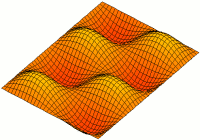
Photo from wikipedia
Abstract Perforated liners are a common form of passive damping device used in engineering applications to damp acoustic pressure fluctuations. The liner has many orifices arranged over the surface with… Click to show full abstract
Abstract Perforated liners are a common form of passive damping device used in engineering applications to damp acoustic pressure fluctuations. The liner has many orifices arranged over the surface with a rear cavity, where the liner can be designed to resonate akin to an array of Helmholtz resonators in parallel. However, whilst a Helmholtz resonator is insensitive to the incident mode, the large surface area and rear cavity of a perforated liner can generate internal mode shapes that affect the acoustic performance. This paper presents a quasi-one-dimensional analytical model capable of capturing the variation in acoustic performance as the internal cavity segmentation is altered with incident higher-order acoustic modes in a narrow annular duct. Thus, the model can allow the generation of circumferential mode shapes. The model shows, when the liner is highly segmented circumferentially, the liner behaviour is akin to that with an incident axial wave. The segmentation causes the internal cavity pressure to fluctuate uniformly at a similar frequency to a Helmholtz resonator with the same effective cavity dimensions. When the cavity length is significant relative to the wavelength, circumferential mode shapes are generated within the cavity and the frequency of resonance increases based on the circumferential frequency component. The model is then compared to an example experimental data set obtained from a facility designed to allow circumferential modes to cut-on simultaneously with an axial mode. A description of the facility and the multi-microphone decomposition method applied to decompose simultaneous modes of unknown orders and relative magnitudes is presented. The model has good agreement with the experimental results for a small cavity segmentation, although there is deviation observed at high frequencies when the cavity length becomes significant relative to the circumferential wavelength.
Journal Title: Journal of Sound and Vibration
Year Published: 2019
Link to full text (if available)
Share on Social Media: Sign Up to like & get
recommendations!